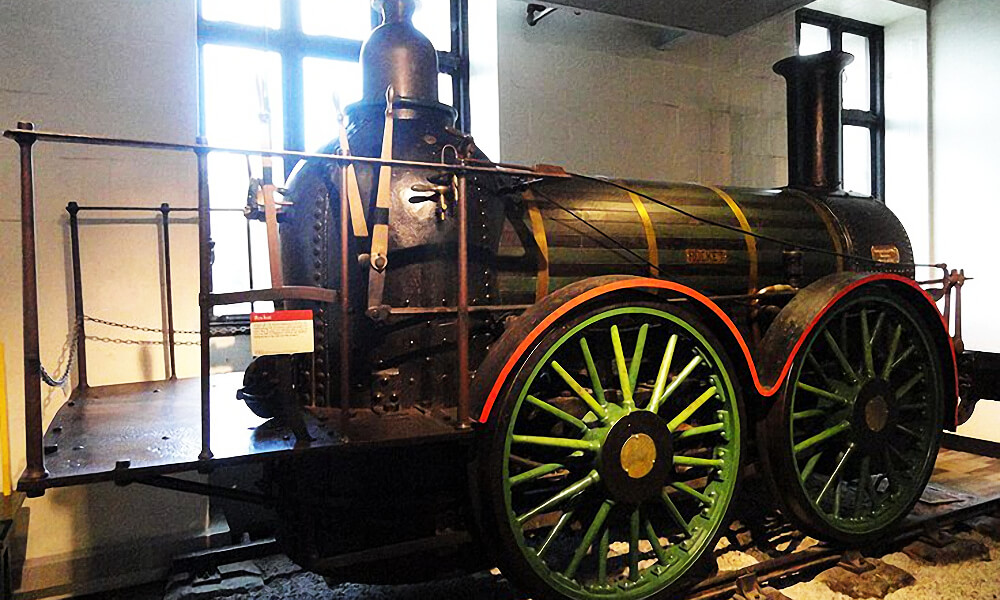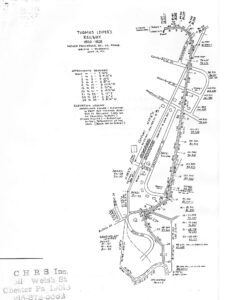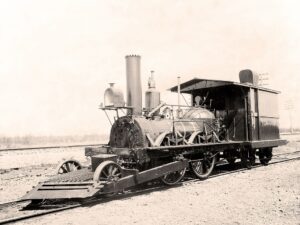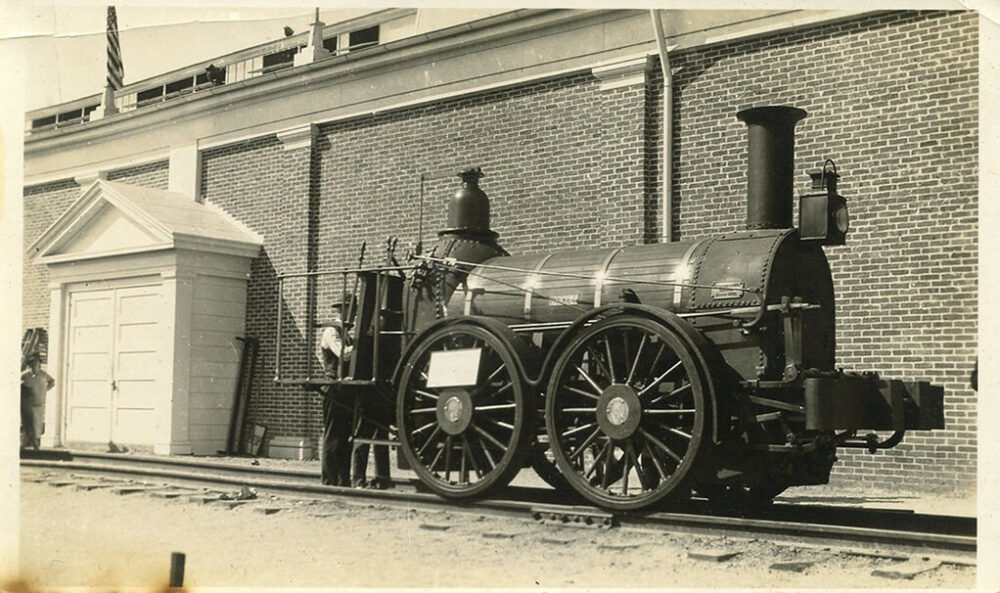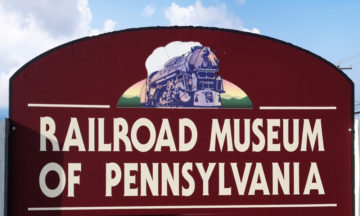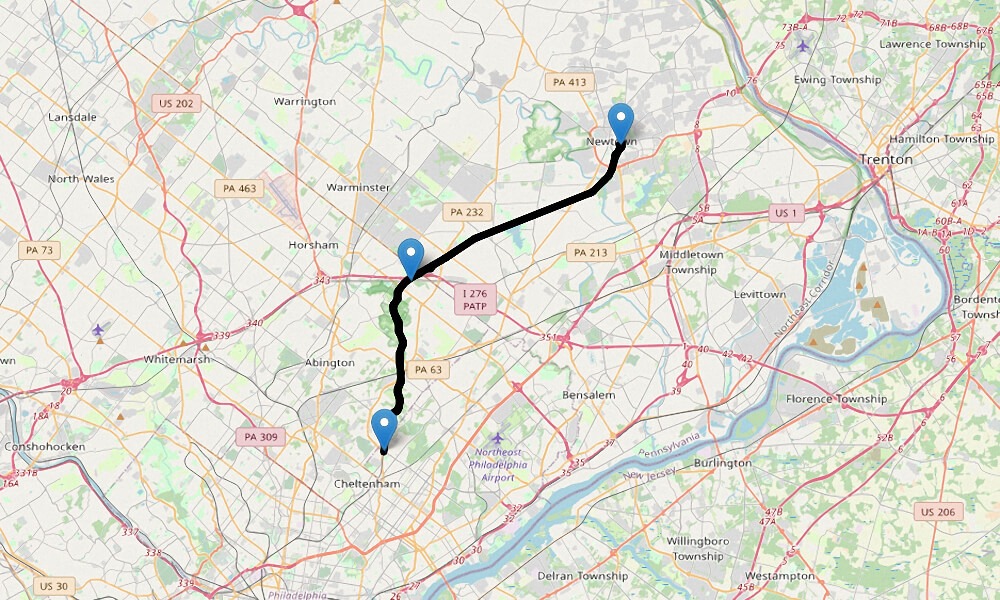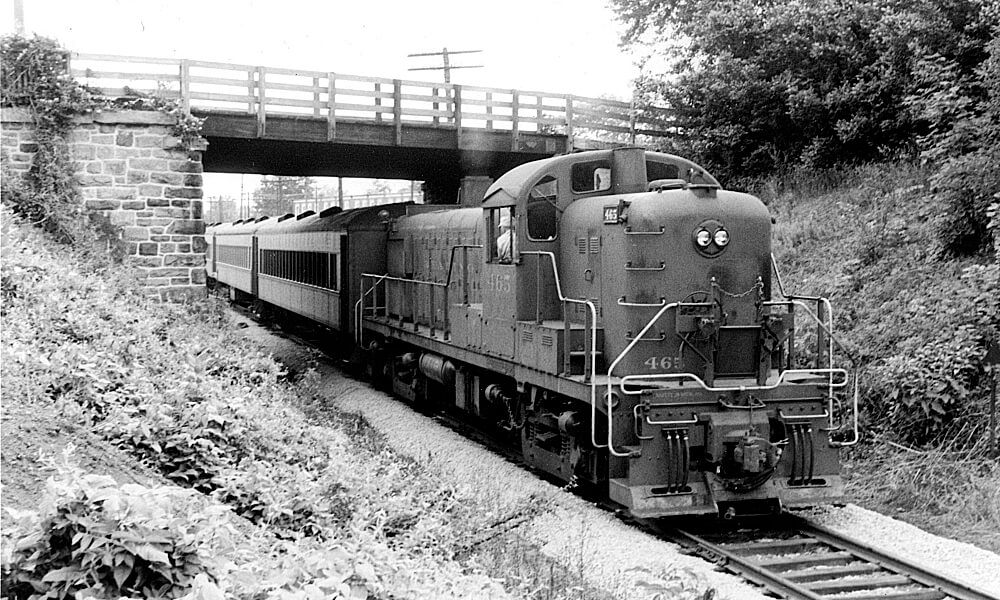An article was recently published about Philadelphia’s famed Franklin Institute — which is in the process of redesigning a major exhibit space — decided to ship its 185-year-old steam-powered locomotive, The Rocket (seen above), off to the Pennsylvania Railroad Museum in Strasburg, Lancaster County, Pennsylvania. While technically “a loan,” the Rail Museum in Strasburg is a perfect home for this historic locomotive. (At the bottom of this article, you’ll find links to two Musings I’ve posted about the Museum.)
With all this said … with the assistance of my trusty webmaster Trishah, I was inspired to look more closely into how railroads first came to America.
Railways were first constructed in England to make it easier to move heavily loaded wheeled vehicles by reducing friction between the road and the wheels.
The First American “Gravity” Road
The first North American gravity (or portage) road is a railroad on a slope that allows cars to coast down the slope by the force of gravity alone.) It was erected in 1764 on the Niagara portage in Lewiston, New York for the military. Before this, all shipments of goods were transported by about 200 local Seneca tribesman over an Indian trail. First the trail was widened in 1763 to accommodate wagons. And then the railway was designed and built by British Captain John Montresor up the face of the cliff.
Over the next 50 years, settlers traveling to the frontier, with the developing need for agriculture and natural resources resulting required new modes of transportation for people and goods. This led to the rise in privately owned toll roads, followed by river steamships and the construction of canals.
Early Surveyor’s
The earliest survey map in the United States that shows a commercial “tramroad” was drawn in Pennsylvania in October 1809 by John Thomson and was entitled “Draft Exhibiting . . . the Railroad as Contemplated by Thomas Leiper Esq. From His Stone Saw-Mill and Quarries on Crum Creek to His Landing on Ridley Creek.” Thomas Leiper was a wealthy Philadelphia tobacconist and friend of Thomas Jefferson, who owned stone quarries near Chester. Using his survey map, Thomson helped Reading Howell, the project engineer and a well-known mapmaker, construct the first practical wooden tracks for a tramroad.
Library of Congress: The Beginnings of American Railroads and Mapping
The Father of American Railroads
John Stevens is considered to be the father of what we know as the modern American railroad. After building and launching a steam-powered ship in 1809, Stevens would go on to demonstrate the viability of steam locomotion for railroads in 1926. He constructed a circular experimental half-mile track on his estate in Hoboken, New Jersey … then proceed to build his own locomotive to operate on it. Shortly thereafter, the State of New Jersey granted him a charter for the Camden and Amboy Railroad, the first railroad charter to be granted in the United States. The line would run from South Amboy, situated on the banks of Raritan Bay south of Staten Island, New York, then onto Camden, located across the Delaware River from Philadelphia.
Before I go on, I must note that there’s a great deal of conflicting information about the development of railroading and its infrastructure during this period. First, son Robert Livingston Stevens would join his father in this venture, and Robert would prove to be as ingenious and far-sighted as his father. It was Robert who conceived and demanded that the rails upon which the trains rode be fully iron. At the time, what was universally in use were wooden rails with an iron strap fastened to the top, which didn’t support heavy cars, didn’t allow much speed, and wore out quickly. Robert’s concept was for a flanged T-shaped iron rail, which is very similar to what’s still in use day … except today’s rails are made of heavy duty steel.
Construction of the Camden and Amboy Railroad began in early 1830, with the first 13 miles of track — from Bordentown to Hightstown — opening for service in the fall of 1832. Meanwhile, Stevens had a locomotive built and shipped from England, the famed John Bull, which arrived in 1831. Other than a brief demonstration, the locomotive was stored until the entire route was completed. In the meantime, all service utilized horse-drawn coaches. The Camden and Amboy Railroad, along with other rail operations throughout central New Jersey, would eventually become part of the Pennsylvania Railroad system.
By the time the entire line was completed in 1838, and the John Bull locomotive was put into service, John and Robert Stevens had purchased additional locomotives to assure good service on their line.
And, yes, the John Bull has been preserved … the original lives in the Smithsonian’s American History museum and a replica can be found in the Railroad Museum of Pennsylvania.
The First American-Built Steam Engine
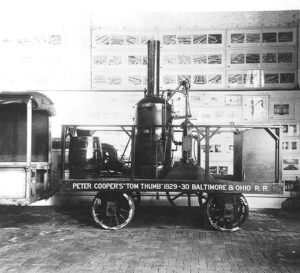
Tom Thumb was the first American-built steam locomotive to operate on a common-carrier railroad. It was designed and constructed by Peter Cooper in 1829 to convince owners of the newly formed Baltimore and Ohio Railroad (B&O) (now CSX) to use steam engines; it was not intended to enter revenue service. It is especially remembered as a participant in a legendary race with a horse-drawn car, which the horse won after Tom Thumb suffered a mechanical failure. (See Relay, Maryland.) However, the demonstration was successful, and the railroad committed to the use of steam locomotion and held trials in the following year for a working engine.
Wikipedia: Tom Thumb (locomotive)
The 1830s saw the beginning of railroads built for steam-powered trains.
And, In New England

As noted above, the route for New England’s first railroad was laid out on a topographical map in 1828. However, the Boston and Providence Railroad was not incorporated and granted a charter until 1831, with construction beginning a year later. In 1834, the first leg was opened from Boston and as far south as Canton (in what may be called the outer suburbs) about one-third of the way to Providence. The entire route would be completed by mid-1835.
Come 1893, the New York, New Haven & Hartford Railroad entered into a lease which included the Boston & Providence. The “New Haven” used the B & P as part of its main line between Boston and New York City. Today, the line is owned by Amtrak, which added electrification in the early 2000s.
The Rocket
The Rocket is a 185-year-old, wood-burning, steam-powered locomotive that once served on the Reading Railroad. Built in 1838, it was the first of eight English engines imported to the United States. It was manufactured by London’s Braithwaite, Milner & Company. This locomotive, weighing 8.5 tons and measuring 17 feet long, is the oldest remaining locomotive from the Philadelphia & Reading Railway, one of the country’s oldest railroads.
The Rocket was delivered to the Port of Philadelphia in 1838. On May 18, 1838, the Rocket traveled by boat on the Schuylkill Canal to Reading, Pennsylvania, for the opening ceremonies of the Reading Canal.
The Rocket initially did not have a roof over the engineer. Later it was redesigned to burn coal and given a covered cab. It’s final years were spent on Richmond Wharves in Philadelphia. After traveling 310,164 miles during its career, the Rocket was retired in March 1879 and sat idle until it was restored and exhibited at the Chicago World’s Fair in 1893.
Recently, the Rocket, which had been on display at the Franklin Institute for 90 years, has been relocated and currently can be seen in its new home at the Railroad Museum of Pennsylvania.
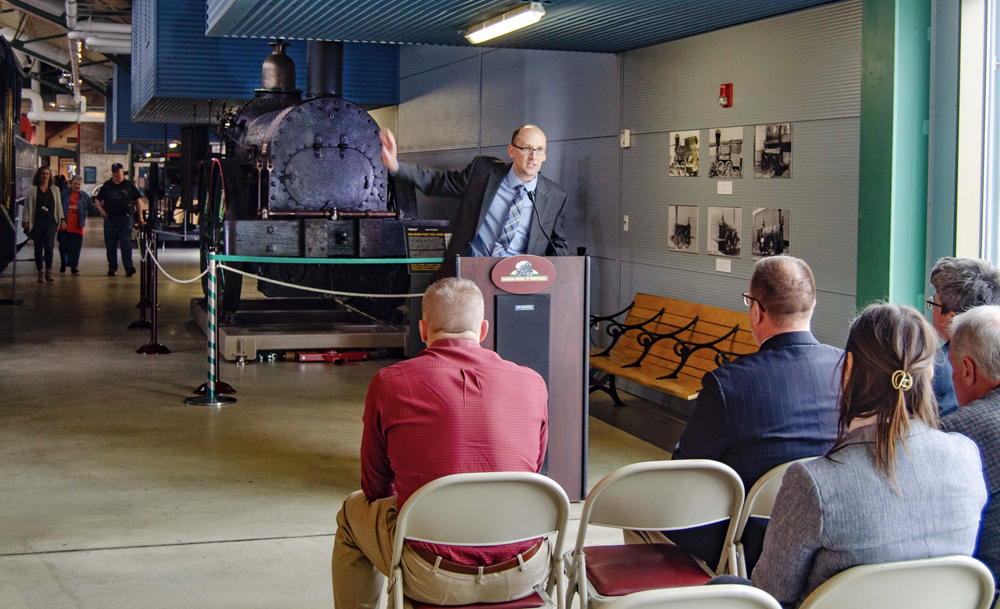
REFERENCES
Library of Congress: The Beginnings of American Railroads and Mapping
The Buffalo History Gazette: The Niagara Portage Railway
Wikipedia: Tom Thumb (locomotive)
Trains.com: 185-year-old ‘Rocket’ moving to Railroad Museum of Pennsylvania
The Railroad Museum of Pennsylvania: Rocket Launch October 27
Hidden City Philadelphia: Riding The Rails With Philly’s “Little Engine That Could”
Image Credits: "The Rocket" Steam Locomotive. Source:Pennsylvania Railroad Museum, Explore PA History: Thomas Lieper's Railway, Library of Congress: First Railway Survey Map, Rocket in the early 1930s before being donated to the Franklin Institute. | Image: Ebay, Trains.com: Opening of a display for Philadelphia & Reading locomotive “Rocket”
